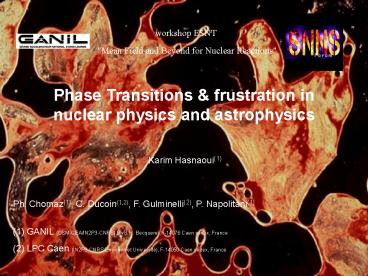Phase Transitions - PowerPoint PPT Presentation
Title:
Phase Transitions
Description:
Ising analogue to compact star matter. Hinteraction=Hnuclear ... ISING = Coulomb modifies the phase-transitions phenomenology = suppression of criticality ... – PowerPoint PPT presentation
Number of Views:17
Avg rating:3.0/5.0
Title: Phase Transitions
1
workshop ESNT "Mean Field and Beyond for Nuclear
Reactions"
Phase Transitions frustration in nuclear
physics and astrophysics
Karim Hasnaoui(1)
Ph. Chomaz(1), C. Ducoin(1,2), F. Gulminelli(2),
P. Napolitani(1) (1) GANIL (DSM-CEA/IN2P3-CNRS),B
lvd. H. Becquerel, F-14076 Caen cédex, France (2)
LPC Caen (IN2P3-CNRS/Ensicaen et Université),
F-14050 Caen cédex, France
2
Nuclear matter and neutron stars
- Matter of neutrons, protons, and electrons.
- Crust of star Þ r/ r0 Î 0.1,1.
3
Motivation of the project
- Exotic phases. (J.C. Pethick D.G. Ravenhall).
- To understand the phenomenology of phase
transitions of nuclear matter. - To study the opalescence of star matter for
neutrino propagation. (C. Horowitz al)
4
Ising analogue to compact star matter
5
Ising analogue to compact star matter
6
Matrice Cij
7
Result 1 Equation of state
system uncharged
system charged
- Liquid-gas coexistence expands with respect to
uncharged nuclear matter gt Ttransition gt Tc
8
Result 2 Criticality
- The phase transition is not of the second order.
- The lengths of correlations do not diverge at
the point of transition.
9
Effective interactions
- The phase-transition phenomenology depends on
the intrinsic interaction gt Necessary to use an
effective interaction. - to take into account
- Fermionic character of the nuclear system.
- Isospin degree of freedom.
10
Fermionic Molecular Dynamics (FMD) (H.Feldmeier
al)
11
Fermionic Molecular Dynamics (FMD) (H.Feldmeier
al)
12
Conclusion and perspectives
- ISING gt Coulomb modifies the phase-transitions
phenomenology gt suppression of criticality - FMD gt to take effective interactions and
dynamics into account. - Other exotic phases of the crust.
- Neutrino propagation.































